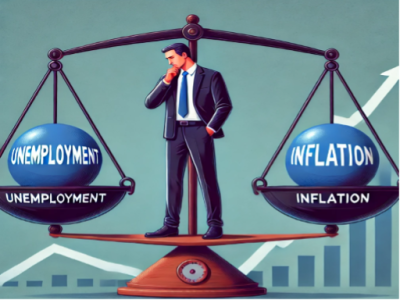Widgetized Section
Go to Admin » Appearance » Widgets » and move Gabfire Widget: Social into that MastheadOverlay zone
Unemployment and Inflation: Can Policymakers Strike the Right Balance?
The views expressed are those of the author and do not necessarily reflect the views of ASPA as an organization.
By Biswanath Bhattacharjee
March 10, 2025

The relationship between unemployment and inflation has long been a critical area of economic study, influencing both monetary and fiscal policy decisions. Generally, as unemployment declines, businesses find it increasingly difficult to hire workers, leading to higher wages and potential inflationary pressures. However, the relationship is not always straightforward, with various economic factors playing a role. Understanding this dynamic is crucial for policymakers aiming to balance economic stability and growth.
The Trade-Off Between Unemployment and Inflation
A decrease in the unemployment rate often results in labor shortages, prompting employers to raise wages to attract and retain employees. While higher wages benefit workers, they also lead to increased production costs for businesses. These costs are frequently passed on to consumers in the form of higher prices, thereby contributing to inflation. This pattern aligns with the traditional Phillips Curve theory, which suggests an inverse relationship between unemployment and inflation.
However, this relationship is not always predictable. Periods of economic instability may see both rising unemployment and increasing prices, defying conventional economic models. External factors such as supply chain disruptions, geopolitical uncertainties and shifts in global trade policies can significantly impact inflation and employment trends, making it difficult to predict their interplay. In some cases, inflation may rise even when unemployment is high, a phenomenon known as stagflation, which occurred in the 1970s.
Lessons from the Great Recession
The Great Recession (2007–2009) presented an anomaly in the unemployment-inflation relationship. During this period, unemployment rose significantly, yet consumer prices declined. This deflationary trend was driven by decreased consumer spending, reduced demand for goods and services and financial sector instability. The recession forced many businesses to decide whether to employ American workers at higher costs or move significant operations offshore to reduce expenses.
Additionally, during economic downturns, lower consumer demand can suppress inflation, even when unemployment is high. The Federal Reserve responded by implementing monetary easing policies, including interest rate cuts and quantitative easing, to stimulate economic growth and stabilize inflation. The recession demonstrated that inflation is not solely dictated by employment levels but is also influenced by consumer confidence, government intervention and market stability.
The Natural Rate of Unemployment and Inflation Control
Economists often reference the “natural rate of unemployment,” which represents the lowest level of unemployment that an economy can sustain without triggering inflation. This concept is closely tied to the Nonaccelerating Inflation Rate of Unemployment (NAIRU), which suggests that if unemployment falls below a certain threshold, inflation will accelerate. The exact NAIRU level varies depending on economic conditions and labor market structures.
Monetary policy plays a crucial role in managing this balance. Central banks, such as the Federal Reserve, often prioritize monetary tools over fiscal policies to control inflation. By adjusting interest rates and regulating the money supply, policymakers attempt to maintain stable economic growth while preventing excessive inflation or unemployment.
Fiscal policy, including government spending and taxation, also influences unemployment and inflation, but it operates on a longer time frame compared to monetary policy. Governments may introduce stimulus measures, such as direct financial aid or tax cuts, to mitigate rising unemployment. However, if not carefully managed, these policies can exacerbate inflationary pressures by increasing demand beyond supply capacity.
Globalization and Its Impact on Inflation and Employment
Globalization has further complicated the relationship between unemployment and inflation. With businesses increasingly outsourcing jobs and moving operations to countries with lower labor costs, domestic employment rates are affected. While this practice can keep production costs low and limit inflationary pressures, it may also contribute to structural unemployment in certain industries.
Conversely, a strong domestic labor market with policies prioritizing local employment can lead to wage-driven inflation. As companies face higher labor costs, they may pass these expenses onto consumers in the form of higher prices. Striking a balance between protecting domestic jobs and maintaining competitive pricing is a challenge for policymakers navigating globalization’s effects.
Conclusion
The relationship between unemployment and inflation is dynamic and influenced by various economic forces. While low unemployment can lead to inflationary pressures through rising wages and production costs, economic downturns can disrupt this pattern. Factors such as globalization, government intervention and external economic conditions further complicate this relationship.
Policymakers must carefully navigate this complex landscape, using monetary and fiscal tools to balance economic growth and price stability. Understanding these nuances is crucial for ensuring long-term economic stability. History has shown that while monetary policy is often the preferred tool for managing inflation, a coordinated approach that considers both fiscal and monetary policies can be more effective. Striking the right balance between inflation and unemployment remains a fundamental challenge in economic governance, requiring constant vigilance and adaptability.
Author: Biswanath Bhattacharjee is a dynamic public administration professional and legal educator with over 20 years of experience spanning academia, legal practice, research, and the nonprofit sector. Holding an MPA from Gannon University, he specializes in management science and quantitative methods. His interdisciplinary expertise drives innovative solutions in governance, policy analysis, and organizational leadership. He can be reached out at [email protected]


 (2 votes, average: 4.50 out of 5)
(2 votes, average: 4.50 out of 5)
Lisa Chambugong
May 6, 2025 at 1:32 pm
An excellent article, best wishes for the writer.